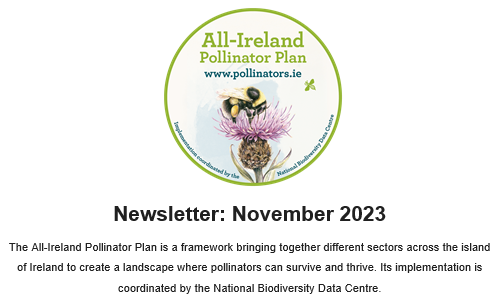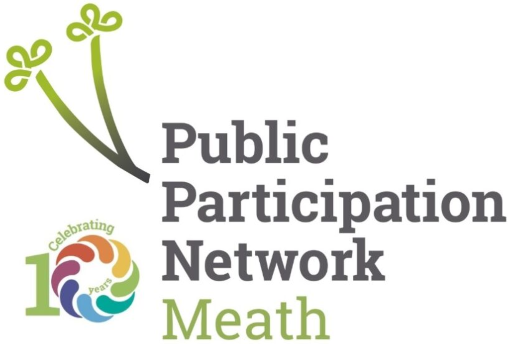All-Ireland Pollinator Plan: November 2023 newsletter
Comments : 0

To spot this month: keep an eye out for queen bumblebees The normal lifecycle of most Irish bumblebees ends when the workers and males die off, and the newly mated queens hibernates through the colder winter months. Occasionally, at this time of year you can still see some bumblebee queens fattening up for hibernation. If you spot any queen bumblebees that you’re able to identify, it’s very useful to let us know what plant it was feeding on. Last November, queens were observed feeding on Ivy and on garden plants like Mahonia, Comfrey and Hebe. Photo below is the Buff-tailed Bumblebee (Joe Curtis). Please submit any bumblebee sightings to the National Biodiversity Data Centre.  Submit your bumblebee sightings To do this month: plant bare root fruit trees Bare-root fruit trees are generally cheaper than potted trees, and the time to buy and plant them is from November to March. Consider adding a small orchard to your garden, local community, business site or farm. As well as helping preserve some of our rare heritage fruit tree varieties, a small orchard can be valuable for biodiversity. They’re made up of several habitats, including elements of woodland, hedgerow and meadow. Over time, this mosaic of habitats can be home to a range of biodiversity, including bees, butterflies, birds, bats, mosses, beetles, fungi and lichen. Windfallen fruit is also a vital source of food in autumn and winter for a whole range of wildlife. Species-rich grassland beneath the trees can be a haven for pollinators and biodiversity, especially if they contain the native, naturally occurring wildflowers. Make sure to include a native Crab Apple tree in your orchard, where you can. Pollinators like wild bees, hoverflies and moths have a vital ‘pollination service’ role in orchards, with almost all fruit resulting from pollination by a bee or other insect. In turn, fruit trees provide nectar and pollen, essential for the survival of these important insects.  Download our guide on Traditional Orchards and Fruit Trees for Pollinators Most pollinator-friendly town/village – Tidy Towns Pollinator Award Winners 2023 Local Communities continue to carry out inspiring work in support of the All-Ireland Pollinator Plan. The Local Authority Pollinator Award aims to encourage groups to implement pollinator-friendly actions in their towns and villages as part of the Tidy Towns competition. It is coordinated and sponsored by the Heritage Offices and Biodiversity Offices of Local Authorities across Ireland, in partnership with the National Biodiversity Data Centre. To date more than 200 communities have become pollinator friendly through the award. Congratulations to all award winners but particularly to the overall 2023 winner, Raheny Tidy Village Group in Dublin. Other awards: Best newcomer: Dalkey Tidy Towns, Co. Dublin Large town winners: Raheny Tidy Village Group, Co. Dublin; Cobh Tidy Towns, Co. Cork; Clonmel Tidy Towns, Co. Tipperary; Buncrana Tidy Towns, Co. Donegal Small town winners: Athboy Tidy Towns, Co. Meath; Sneem Tidy Towns. Co. Kerry; Tullahought Community Development Ltd., Co. Kilkenny; Belmullet Tidy Towns/ Baile Slachtmhar Bhéal an Mhuirthead, Co. Mayo The following were highly commended: Abbeyleix Tidy Towns, Balbriggan Tidy Towns, Castlegregory Tidy Towns, Skerries Tidy Towns, Tyrrellspass Tidy Towns, Woodford Parish Development.  Read more New Resource: flyer on pollinator-friendly sensory gardens The All-Ireland Pollinator Plan is delighted to release a new free flyer on creating pollinator-friendly sensory gardens. Sensory gardens are spaces that offer opportunities to connect with nature through the five senses: sight, sound, touch, smell, and taste. Studies show that spending time in nature and connecting with the world around us is good for our health and wellbeing. Big or small, a sensory garden can be a wonderful addition to a community space, school, healthcare site, business, or even your own home. Fill it with pollinator-friendly plants that feed our wild bees, stimulate the senses, and create a vibrant and relaxing haven for people and pollinators. Note: while sensory gardens should contain as many native plants as possible, this is largely a horticultural action and should be kept strictly to garden settings.  Read more & download flyer Blog: where do pollinators go in winter? Learn how our bumblebees, solitary bees, hoverflies and moths survive the cold winter months. Read this blog from Ruth Wilson, the farmland pollinator officer.  Read more All-Ireland Bumblebee Monitoring Scheme: 2012-2022 report released The All-Ireland Bumblebee Monitoring Scheme, established by the National Biodiversity Data Centre in 2012, is one of the first of its kind globally. It tracks bumblebees and uses the status of the 8 commonest species to generate a multi-species population index as a measure of the health of Ireland’s bumblebee populations. It provides vital baseline data that will be used to assess the impact of the All-Ireland Pollinator Plan. The scheme involves volunteers walking a fixed route (transect) each month from March to October and counting all the bumblebees seen. It represents a huge voluntary effort by citizen scientists. In 2022, 76 volunteers walked more than 1,000km and counted 17,980 individual bumblebees. The current overall trend from 2012-2021 is a year-on-year decline of 3.3%. Bombus pascuroum (Common Carder Bee) has traditionally been one of our most common bumblebees, but is now showing a moderate decline. Unfortunately, Bombus muscorum (Large Carder Bee) is in severe decline. The Tree Bumblebee (Bombus hypnorum) is our most recent bumblebee arrival, being first recorded from the island of Ireland in Autumn 2017. It was recorded in the scheme for the first time in 2021. In 2022, it was picked up in low numbers on three transects in N. Ireland. In response to the findings of the scheme, an evidence-based guideline document on how local communities can help protect the Large Carder Bee was published by the All-Ireland Pollinator Plan in 2022.  National Biodiversity Data Centre: latest trends from the Butterfly and Bumblebee Monitoring Schemes Resources on helping the Large Carder Bee To spot this month: keep an eye out for queen bumblebees The normal lifecycle of most Irish bumblebees ends when the workers and males die off, and the newly mated queens hibernates through the colder winter months. Occasionally, at this time of year you can still see some bumblebee queens fattening up for hibernation. If you spot any queen bumblebees that you’re able to identify, it’s very useful to let us know what plant it was feeding on. Last November, queens were observed feeding on Ivy and on garden plants like Mahonia, Comfrey and Hebe. Photo below is the Buff-tailed Bumblebee (Joe Curtis). Please submit any bumblebee sightings to the National Biodiversity Data Centre.  Submit your bumblebee sightings To do this month: plant bare root fruit trees Bare-root fruit trees are generally cheaper than potted trees, and the time to buy and plant them is from November to March. Consider adding a small orchard to your garden, local community, business site or farm. As well as helping preserve some of our rare heritage fruit tree varieties, a small orchard can be valuable for biodiversity. They’re made up of several habitats, including elements of woodland, hedgerow and meadow. Over time, this mosaic of habitats can be home to a range of biodiversity, including bees, butterflies, birds, bats, mosses, beetles, fungi and lichen. Windfallen fruit is also a vital source of food in autumn and winter for a whole range of wildlife. Species-rich grassland beneath the trees can be a haven for pollinators and biodiversity, especially if they contain the native, naturally occurring wildflowers. Make sure to include a native Crab Apple tree in your orchard, where you can. Pollinators like wild bees, hoverflies and moths have a vital ‘pollination service’ role in orchards, with almost all fruit resulting from pollination by a bee or other insect. In turn, fruit trees provide nectar and pollen, essential for the survival of these important insects.  Download our guide on Traditional Orchards and Fruit Trees for Pollinators Most pollinator-friendly town/village – Tidy Towns Pollinator Award Winners 2023 Local Communities continue to carry out inspiring work in support of the All-Ireland Pollinator Plan. The Local Authority Pollinator Award aims to encourage groups to implement pollinator-friendly actions in their towns and villages as part of the Tidy Towns competition. It is coordinated and sponsored by the Heritage Offices and Biodiversity Offices of Local Authorities across Ireland, in partnership with the National Biodiversity Data Centre. To date more than 200 communities have become pollinator friendly through the award. Congratulations to all award winners but particularly to the overall 2023 winner, Raheny Tidy Village Group in Dublin. Other awards: Best newcomer: Dalkey Tidy Towns, Co. Dublin Large town winners: Raheny Tidy Village Group, Co. Dublin; Cobh Tidy Towns, Co. Cork; Clonmel Tidy Towns, Co. Tipperary; Buncrana Tidy Towns, Co. Donegal Small town winners: Athboy Tidy Towns, Co. Meath; Sneem Tidy Towns. Co. Kerry; Tullahought Community Development Ltd., Co. Kilkenny; Belmullet Tidy Towns/ Baile Slachtmhar Bhéal an Mhuirthead, Co. Mayo The following were highly commended: Abbeyleix Tidy Towns, Balbriggan Tidy Towns, Castlegregory Tidy Towns, Skerries Tidy Towns, Tyrrellspass Tidy Towns, Woodford Parish Development.  Read more New Resource: flyer on pollinator-friendly sensory gardens The All-Ireland Pollinator Plan is delighted to release a new free flyer on creating pollinator-friendly sensory gardens. Sensory gardens are spaces that offer opportunities to connect with nature through the five senses: sight, sound, touch, smell, and taste. Studies show that spending time in nature and connecting with the world around us is good for our health and wellbeing. Big or small, a sensory garden can be a wonderful addition to a community space, school, healthcare site, business, or even your own home. Fill it with pollinator-friendly plants that feed our wild bees, stimulate the senses, and create a vibrant and relaxing haven for people and pollinators. Note: while sensory gardens should contain as many native plants as possible, this is largely a horticultural action and should be kept strictly to garden settings.  Read more & download flyer Blog: where do pollinators go in winter? Learn how our bumblebees, solitary bees, hoverflies and moths survive the cold winter months. Read this blog from Ruth Wilson, the farmland pollinator officer.  Read more All-Ireland Bumblebee Monitoring Scheme: 2012-2022 report released The All-Ireland Bumblebee Monitoring Scheme, established by the National Biodiversity Data Centre in 2012, is one of the first of its kind globally. It tracks bumblebees and uses the status of the 8 commonest species to generate a multi-species population index as a measure of the health of Ireland’s bumblebee populations. It provides vital baseline data that will be used to assess the impact of the All-Ireland Pollinator Plan. The scheme involves volunteers walking a fixed route (transect) each month from March to October and counting all the bumblebees seen. It represents a huge voluntary effort by citizen scientists. In 2022, 76 volunteers walked more than 1,000km and counted 17,980 individual bumblebees. The current overall trend from 2012-2021 is a year-on-year decline of 3.3%. Bombus pascuroum (Common Carder Bee) has traditionally been one of our most common bumblebees, but is now showing a moderate decline. Unfortunately, Bombus muscorum (Large Carder Bee) is in severe decline. The Tree Bumblebee (Bombus hypnorum) is our most recent bumblebee arrival, being first recorded from the island of Ireland in Autumn 2017. It was recorded in the scheme for the first time in 2021. In 2022, it was picked up in low numbers on three transects in N. Ireland. In response to the findings of the scheme, an evidence-based guideline document on how local communities can help protect the Large Carder Bee was published by the All-Ireland Pollinator Plan in 2022.  National Biodiversity Data Centre: latest trends from the Butterfly and Bumblebee Monitoring Schemes Resources on helping the Large Carder Bee |

